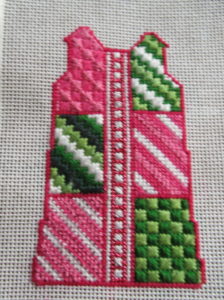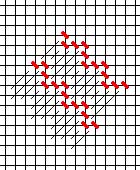
Today we finish up stitching this pink patchwork mini shift from Two Sisters. It has two wonderful aspects that make this a great project. First, although there aren’t lots of colors, this design is a great stash project because you can use small amounts of these colors. Second, the painted stitches designs of the patches make it a great project for beginners.
Today we finish up the design with the four patches that have diagonal stripes.
Steppped Stripes
When you see diagonal stripes that move by steps, you’ll need to look more closely to see what stitches can be used. Some stitches that you might consider, none used here, are: Byzantine, Jacquard, any box stitch done in steps, Hesitation Stitch, and Diagonal Cashmere. If the diagonal stripes are made of triangles, try Milanese. The stitches that will work in your patch depend on what is painted.
In the upper right patch, there are diagonal stripes in white and light green that change in width. These are separated by narrow stripes in green. That pattern of rows of Tent (narrow stripes) separating rows of Diagonal Scotch (changing stripes) is Reverse Moorish Stitch below.

The left-center patch has stripes that change their width in white and all three greens. because the units are the same size horizontally and vertically and there are more than two stitches in different widths, we know this is Reverse Diagonal Scotch, below. If ther dimensions were uneven, it would be Diagonal Cashmere. If the stripes alternated between two lengths it would be Diagonal Mosaic.

Diagonal Satripe Patches
Straight diagonal stripes are a bit more difficult because the stitch choices are smaller. Reverse Tent, below, can often be used. It’s used here in the dark pink stripes in both the right center patch and in the bottom left patch.

In the center right patch, the pink and white stripes are stitched in Tent. This creates stripes that alternate in stitch direction. This is a great way to handle even-width stripes that are wider than one intersection.
When there are single-intersection stripes that are always on the same type of intersection, these can always be stitched in Reverse Tent.These can create solid lines between the wide areas of Four-way Continental, below. This type of pattern only works if the narrow stripes are always on the same type of intersection. That’s needed to make the stitch work out.

Next week, we’ll start another stash project, a Zeecca canvas, that will feature stitches for triangles and circles. It’s Party Hats, the first canvas under card cases.
About Janet M Perry
Janet Perry is the Internet's leading authority on needlepoint. She designs, teaches and writes, getting raves from her fans for her innovative techniques, extensive knowledge and generous teaching style. A leading writer of stitch guides, she blogs here and lives on an island in the northeast corner of the SF Bay with her family

Leave a Reply